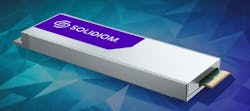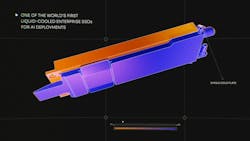Cold-Plate SSD Targets Liquid-Cooled Servers
You knew it was coming. Liquid cooling is becoming mainstream and critical to addressing cloud-computing needs such as support for artificial intelligence (AI). This is needed not only for CPUs, GPUs, and AI accelerators, but also for the support components from DRAM to solid-state drives (SSDs).
Solidigm’s E1.S D7-PS1010 SSD (Fig. 1) incorporates a cold plate to conduct heat from the SSD to the liquid-cooling systems, also known as liquid flow through (LFT). It allows for hotter SSDs that run faster and have a higher capacity than convection/air-cooled solutions, also known as air-flow-through (AFT) systems. AFT and LFT solutions are used in the data center as well as in rugged embedded systems.
Cold Plates and Heat Conduction in a Liquid-Cooled Environment
Immersion-cooling systems, also known as fluid flow through (FFT), surrounds the device with liquid coolant. It’s effective but requires specially designed devices and containment. This isn’t the approach used with most liquid-cooled systems to date. They actually employ conduction cooling using a cold plate that’s essentially a metal heatsink or heat spreader, which is in turn tied to a liquid-cooling system. This is often referred to as direct-to-chip cooling, especially when talking about CPU and GPU cooling systems.
With CPU and GPU direct-to-chip cooling, the device has a heatsink that incorporates a chamber for the cooling liquid. Typically, there’s a single input and an output port to move the coolant through the system. These are occasionally daisy-chained and connected to a heat exchanger at some point, where the heat is removed. This is often an air-cooled system far from the devices that require cooling. The heat exchanger isn’t designed to be removed, except when the system isn’t running.
>>Check out more of our Future of Storage and Memory Conference 2025 coverage, as well as the TechXchange for similar articles and videos
A cold-plate system is typically used in removable board or module systems that have the coolant circulating through a chassis where the boards or modules are installed. The liquid doesn’t come in direct contact with any of the boards or modules. Instead, these have a cold plate on at least one edge that comes in contact with a similar plate in the chassis. The heat is moved from the device through the plates to the liquid coolant, where the heat is then transferred to the external cooling system.
A Removable Cold-Plate SSD
Solidigm’s hot-swappable D7-PS1010 SSD is an LFT solution with a spring-loaded cold plate that meets the 9.5-mm E1.S standard (Fig. 2). It’s designed to plug into a liquid-cooled chassis. The drive employs a x4 PCI Express (PCIe) Gen 5 interface with capacities in excess of 15 TB. It’s also available in a 15-mm U.2 form factor.
The SSDs are populated with 176-layer, TLC 3D NAND. The family has a sequential read bandwidth of 14,500 MB/s and a write bandwidth of 4,100 MB/s. And they maintain a read latency of 60 μs and write latency of 7 to 8 μs. The mean time between failures (MTBF) is 2.5 million hours.
The SE models can deliver 1.0 drive writes per day (DWPD). Maximum lifetime program/erase cycles are on the order of 28 petabytes written (PBW) for the 15.36-TB variant over a five-year period.
Watch the video below for more on the D7-PS1010:
Cold-Plate SSD Impact on AI
AFT has been the norm in data centers, but LFT is making inroads due to the growing demand to support more dense and hotter chips. This growth has been even more significant with the upswing in AI use, as new data centers are being built to support AI compute demands.
Adding LFT SSDs to the mix matches the move to CPUs, GPUs, and AI accelerators, as well as SmartNICs and DPUs. Chips are becoming larger and hotter as designers adopt approaches like chiplets to pack more compute and storage into a smaller form factor.
>>Check out more of our Future of Storage and Memory Conference 2025 coverage, as well as the TechXchange for similar articles and videos
About the Author
William G. Wong
Senior Content Director - Electronic Design and Microwaves & RF
I am Editor of Electronic Design focusing on embedded, software, and systems. As Senior Content Director, I also manage Microwaves & RF and I work with a great team of editors to provide engineers, programmers, developers and technical managers with interesting and useful articles and videos on a regular basis. Check out our free newsletters to see the latest content.
You can send press releases for new products for possible coverage on the website. I am also interested in receiving contributed articles for publishing on our website. Use our template and send to me along with a signed release form.
Check out my blog, AltEmbedded on Electronic Design, as well as his latest articles on this site that are listed below.
You can visit my social media via these links:
- AltEmbedded on Electronic Design
- Bill Wong on Facebook
- @AltEmbedded on Twitter
- Bill Wong on LinkedIn
I earned a Bachelor of Electrical Engineering at the Georgia Institute of Technology and a Masters in Computer Science from Rutgers University. I still do a bit of programming using everything from C and C++ to Rust and Ada/SPARK. I do a bit of PHP programming for Drupal websites. I have posted a few Drupal modules.
I still get a hand on software and electronic hardware. Some of this can be found on our Kit Close-Up video series. You can also see me on many of our TechXchange Talk videos. I am interested in a range of projects from robotics to artificial intelligence.





